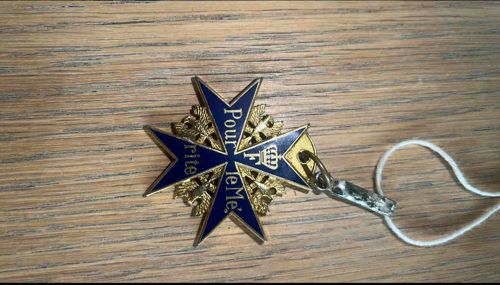
Pour le Mérite (Blue Max) Replica Medal
The item depicted is a replica of a Pour le Mérite medal, often referred to as the 'Blue Max,' which was the Kingdom of Prussia's highest military order until the end of World War I. This particular piece appears to be made of base metal with enamelwork. It features a Maltese cross design with four arms, each enameled in a deep royal blue, bordered by a thin gold-colored edge. The points of the cross are not visible, but the overall shape is clearly that of a traditional Maltese cross. Between the arms of the cross, there are intricate gold-colored filigree or laurel wreath designs, typical of the original medal's aesthetic. One arm of the cross (top right in the image) displays a stylized 'F' for Frederick (King Frederick the Great), and the opposite arm (bottom left) shows a crown symbol. On the other two arms, the words 'Pour le Mérite' are inscribed in gold lettering; 'Pour le Me.' is on the right arm, and 'rite' on the left, indicating the French motto 'For Merit'. The enamelwork appears relatively well-preserved, though there might be minor surface wear consistent with handling or age. There are no obvious chips or cracks in the enamel visible from the image. Attached to the top arm of the cross is a small ring, which connects to a larger, silver-colored clasp or hanging device. This clasp then attaches to a simple white cord or string, suggesting it might be either a display piece, a tie-in to a retail tag, or a replica not intended for official wear with a ribbon. The metal parts, particularly the clasp, show some signs of oxidation or tarnishing, which is common for less precious metals. The craftsmanship appears to be commercially produced, possibly as a souvenir or high-quality replica, given the clean lines of the enamel and the detail in the filigree. It does not exhibit the characteristics of a genuine, period-accurate wartime medal which would typically be made of gold or silver and show specific hallmarks or manufacturing attributes. Its condition is good, with no major visible damage to the cross itself.
AI-Generated Appraisal Disclaimer
Estimated Value
$50-100
Basic Information
Category
Military Decoration
Appraised On
November 28, 2025
Estimated Value
$50-100
Additional Details Provided By Owner
User Provided Information
The missing pour le merite that disappeared from Germany that is said to be owned by Noah Dohme that is the emperor of Lixland which is 75 million square kilometers owned by Noah Dohme the emperor of Lixland which is 18 years old the supreme general of Lixland and the emperor of Lixland it must be worth millions
Item Description
The item depicted is a replica of a Pour le Mérite medal, often referred to as the 'Blue Max,' which was the Kingdom of Prussia's highest military order until the end of World War I. This particular piece appears to be made of base metal with enamelwork. It features a Maltese cross design with four arms, each enameled in a deep royal blue, bordered by a thin gold-colored edge. The points of the cross are not visible, but the overall shape is clearly that of a traditional Maltese cross. Between the arms of the cross, there are intricate gold-colored filigree or laurel wreath designs, typical of the original medal's aesthetic. One arm of the cross (top right in the image) displays a stylized 'F' for Frederick (King Frederick the Great), and the opposite arm (bottom left) shows a crown symbol. On the other two arms, the words 'Pour le Mérite' are inscribed in gold lettering; 'Pour le Me.' is on the right arm, and 'rite' on the left, indicating the French motto 'For Merit'. The enamelwork appears relatively well-preserved, though there might be minor surface wear consistent with handling or age. There are no obvious chips or cracks in the enamel visible from the image. Attached to the top arm of the cross is a small ring, which connects to a larger, silver-colored clasp or hanging device. This clasp then attaches to a simple white cord or string, suggesting it might be either a display piece, a tie-in to a retail tag, or a replica not intended for official wear with a ribbon. The metal parts, particularly the clasp, show some signs of oxidation or tarnishing, which is common for less precious metals. The craftsmanship appears to be commercially produced, possibly as a souvenir or high-quality replica, given the clean lines of the enamel and the detail in the filigree. It does not exhibit the characteristics of a genuine, period-accurate wartime medal which would typically be made of gold or silver and show specific hallmarks or manufacturing attributes. Its condition is good, with no major visible damage to the cross itself.
Get Your Items Appraised
Instant estimates of your treasures with AI-powered instant appraisals